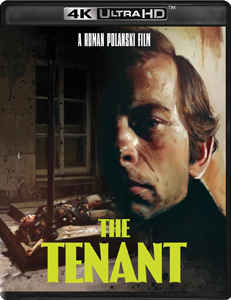“Repulsion” (1965) has aged incredibly well, a modern-seeming story of a woman’s troubled mind. “Rosemary’s Baby” (1968), though slow by today’s standards, is a classic people keep going back to; it even spawned a prequel this year.
The final installment of director Roman Polanski’s Apartment Trilogy of horror movies, the English-language French film “The Tenant” (1976), has been the most ravaged by time. But it’s important for its influence on the “Things aren’t quite what they seem” storytelling structure.
Polanski does double duty
Perhaps not trusting anyone else to play mild-mannered apartment-seeker Mr. Trelkovsky, Polanski has the title role. This is as ugly as Paris has ever looked on screen, but it’s a landlord’s market. Trelkovsky has to jump on the dark, dingy flat, even though the previous tenant jumped out the window and isn’t dead yet – she’s in a coma.

“The Tenant” (1976)
Director: Roman Polanski
Writers: Gérard Brach, Roman Polanski (screenplay); Roland Topor (novel)
Stars: Roman Polanski, Isabelle Adjani, Melvyn Douglas
And even though there’s no bathroom in the unit; just a shared one down the hall. Trelkovsky, who does some sort of government paper-pushing to make ends meet, invites his loud and annoying work colleagues over, and one of them pisses in the sink rather than walk down the winding corridors.
The building is not ideal for someone who’s not wildly social, as Trelkovsky worries about being sick and needing to use the communal bathroom. He looks across the courtyard at the bathroom window and there’s often someone there, staring back at him. The whole movie is an introvert’s nightmare.
It’s also a portrait of a man losing his mind – but in a different way from the women in the previous Apartment Trilogy entries. The woman in “Repulsion” is autistic, so she knows there’s something socially off about her but can’t help it. The woman in “Rosemary’s Baby” isn’t crazy at all; she’s being gaslit into thinking she’s crazy.
Which of the oddities have a purpose?
(SPOILERS FOLLOW.)
Trelkovsky is crazy but is unaware of it; he believes he’s being gaslit by his landlord and neighbors who lambast him for every minor slight, such as having that one-off noisy gathering. He’s the “Repulsion” woman thinking he’s in a “Rosemary’s” situation.
Polanski uses the subtle tricks horror and suspense maestros have utilized through the years, from Hitchcock’s “Vertigo,” which predates this, to later films like Kubrick’s “The Shining,” Shyamalan’s “The Sixth Sense,” Fincher’s “Fight Club” and Aronofsky’s “Mother!” In a nutshell, the world presented by “The Tenant” is off-kilter – sometimes a little, sometimes a lot.

Why are there hieroglyphics in the bathroom? Why is there a tooth in the wall? Why does Trelkovsky see people’s faces changing? Is it as simple as “He’s crazy”?
Some elements aren’t overtly brought to our attention, but – given that Polanski is an established auteur at this point — they are not likely to be plot holes or technical screw-ups. Why are all of the previous tenant’s things still there? Why is this place being rented to him while she’s still alive? Trelkovsky is dating a woman – Stella (Isabelle Adjani, who looks like Molly Ringwald) — who was close friends with the previous tenant. They have lots of scenes together yet the previous tenant rarely comes up in conversation.
And why are several characters’ voices dubbed? The movie apparently hired French actors, then later hired English voiceover actors. Was this for logistical reasons, or creative reasons?
The void of identity
“The Tenant” aims to provoke thought, and while it’s easy to follow what’s happening (as weird as it may be), it doesn’t exactly lay out a study guide for viewers. One exception is Trelkovsky’s musings about what defines “self”:
“And now, if you cut off my head, would I say, ‘Me and my head’ or ‘Me and my body’? What right has my head to call itself me? What right?”
It seems like there should be more layers – and maybe there are. Polanski, co-writing with Gerard Brach from Roland Topor’s novel, asks the viewer to trust him; to know that these are not mistakes in the narrative, they are oddities to keep us off-balance.
I feel thrilled after watching “Repulsion,” knowing I’ve witnessed high art. I feel the historical importance of “Rosemary’s” in the advancement of the horror genre. The experience of watching “The Tenant” is depressing, dirty, dull drudgery.
It’s loneliness and emptiness made manifest as a piece of cinema. I’m kind of suspicious it might be a brilliant film that captures a truism of living, yet I also know it’s unhealthy for me to watch. Learning more about “The Tenant’s” symbols and hidden meanings will be enjoyable. I don’t want to watch it again, though, and I shouldn’t.

